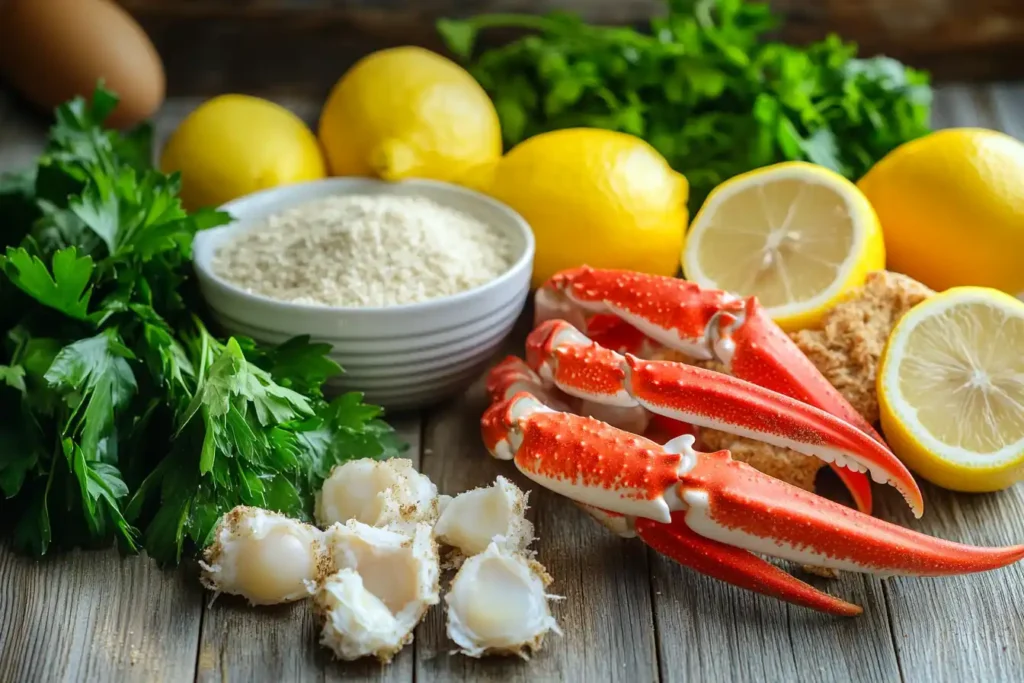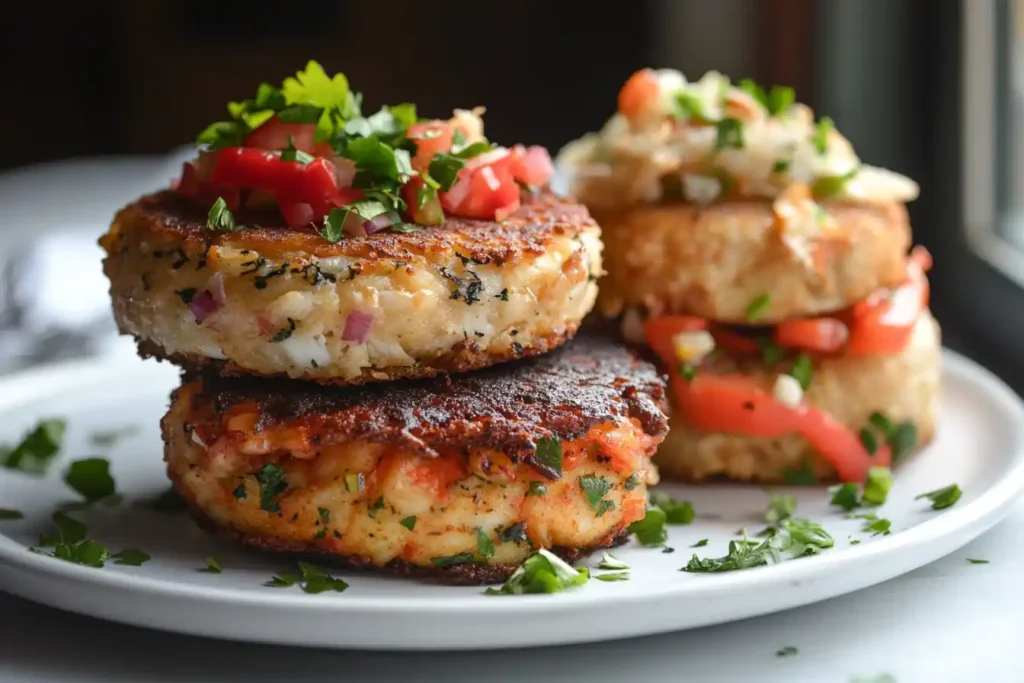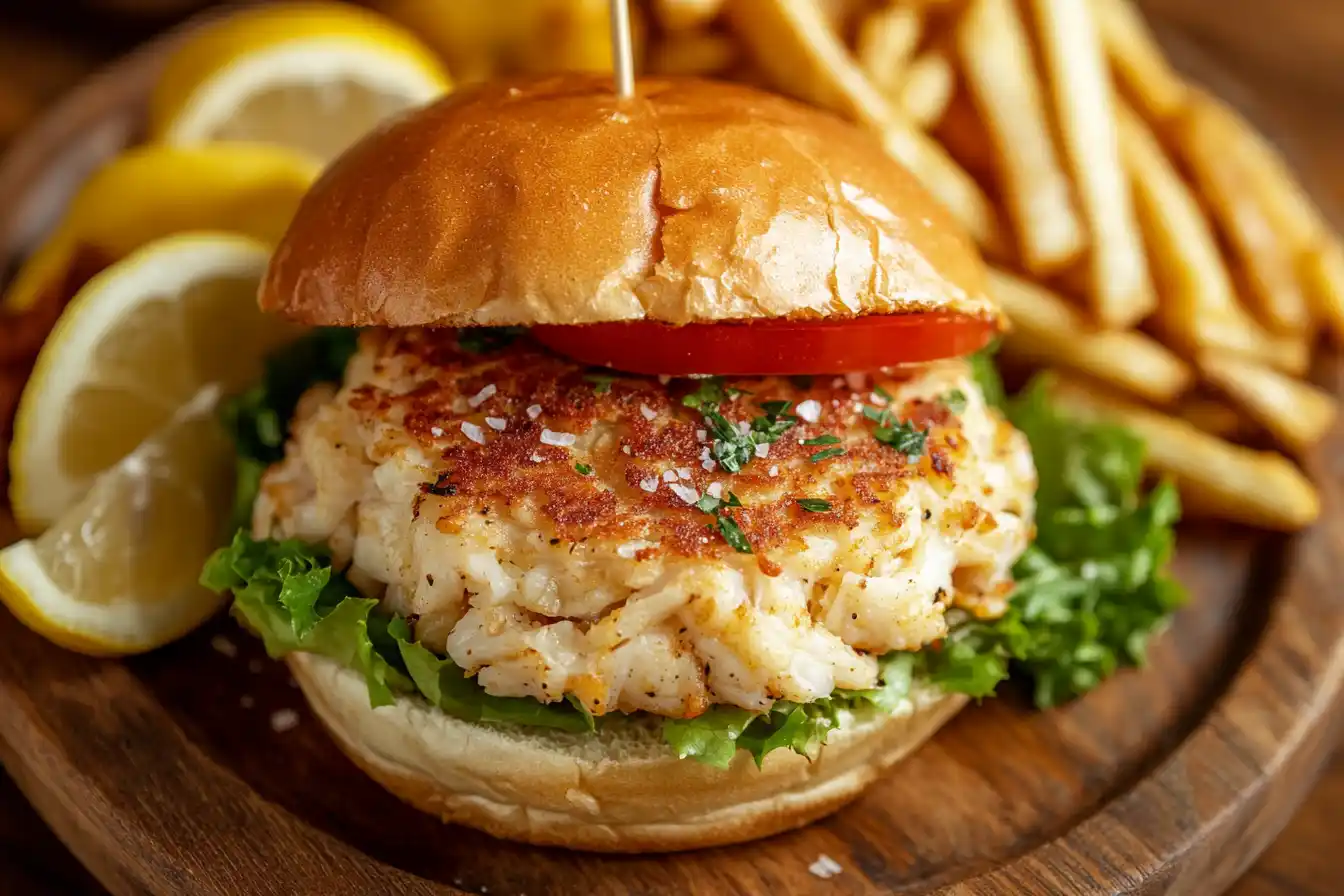Few dishes capture the essence of coastal flavors as perfectly as the crab cake sandwich. This delectable creation combines succulent, tender crab meat with a crisp, golden crust, tucked between two slices of soft, flavorful bread. Whether served with a tangy tartar sauce or a dollop of spicy aioli, a crab cake sandwich is more than a meal—it’s an experience.
What makes this dish so irresistible? It’s the harmonious blend of textures and flavors. The delicate sweetness of fresh crab meat, paired with the rich savoriness of seasonings and the freshness of accompaniments like lettuce, tomato, or slaw, creates a bite that feels both indulgent and refreshing. And while the dish has humble beginnings, its versatility makes it a star on restaurant menus and in home kitchens alike.
In this guide, we’ll dive into everything you need to know about the crab cake sandwich: its history, the ingredients that make it shine, how to create your own masterpiece, and where to find the best versions across the U.S. Whether you’re a seafood enthusiast or a curious foodie, you’re in for a treat!
Table of Contents
A Brief History of Crab Cake Sandwiches
The Origin of Crab Cakes
Crab cakes have deep roots in coastal cuisines, particularly in Maryland, where blue crabs are a local treasure. This dish dates back to early colonial America when settlers combined local seafood with European cooking techniques. Crab cakes were originally made with simple ingredients—crab meat, bread, and spices—and were pan-fried to perfection.
How the Sandwich Came to Be
The idea of putting a crab cake on bread likely emerged as a convenient way to enjoy this delicacy. By the 20th century, the crab cake sandwich became a staple at diners and seafood shacks along the Eastern Seaboard. Today, it’s a celebrated dish that has evolved to include endless variations while maintaining its classic appeal.
Key Ingredients for a Delicious Crab Cake Sandwich

Choosing the Right Crab Meat
The foundation of any great crab cake sandwich lies in the quality of the crab meat. While there are various types of crab available, lump crab meat is the gold standard for this dish. Its large, tender chunks provide the perfect texture and flavor. Other options, such as jumbo lump or backfin meat, can also work well, depending on your preference and budget.
Tips for Selecting Crab Meat:
- Freshness is Key: Always opt for fresh or refrigerated crab meat rather than canned options for the best flavor.
- Check the Label: If using packaged crab meat, ensure it’s labeled as “pasteurized” for longer shelf life without compromising quality.
- Sustainability Matters: Consider purchasing crab meat from sources certified for sustainable practices to support eco-friendly seafood harvesting.
Essential Ingredients for the Crab Cake
A great crab cake balances simplicity with bold flavor. Here’s what you’ll need:
- Binder: Eggs and mayonnaise are essential for holding the crab mixture together. They also add richness and moisture.
- Fillers: Minimal fillers like breadcrumbs or crushed crackers are used to give structure without overpowering the crab. Maryland-style crab cakes, for instance, are famous for being light on fillers.
- Seasonings: Old Bay seasoning is a classic choice, lending a distinctive, slightly spicy kick. Additional ingredients like Dijon mustard, Worcestershire sauce, parsley, and lemon juice can enhance the flavor.
- Aromatics: Chopped onions or shallots add a subtle sweetness and complexity.
The Perfect Bread: Options for the Best Sandwich Experience
The bread is just as crucial as the crab cake itself. You’ll want something sturdy enough to hold up to the juicy crab cake without overwhelming the flavors. Popular choices include:
- Brioche Buns: Buttery and soft, these buns add a touch of sweetness.
- Potato Rolls: Fluffy and slightly chewy, perfect for a traditional sandwich feel.
- Kaiser Rolls: Crisp on the outside and airy on the inside, ideal for a rustic presentation.
- Gluten-Free Options: For those with dietary restrictions, gluten-free sandwich buns are widely available and work well when toasted.
Pro Tip:
Lightly toast the bread to prevent it from getting soggy and to add a pleasant crunch to every bite.
How to Make the Perfect Crab Cake Sandwich at Home
Crafting a crab cake sandwich at home is easier than you might think, and the results are well worth the effort. Below, we’ll guide you through making everything from the crab cakes to assembling the sandwich for a restaurant-quality dish.
Step-by-Step Recipe for the Crab Cakes
Ingredients for the Crab Cakes:
- 1 lb lump crab meat (picked over for shells)
- 1 large egg
- 2 tbsp mayonnaise
- 1 tsp Dijon mustard
- 1 tsp Worcestershire sauce
- 1 tsp Old Bay seasoning
- 1 tbsp fresh lemon juice
- 2 tbsp chopped parsley
- ½ cup breadcrumbs or crushed crackers
- Salt and pepper to taste
- 2 tbsp unsalted butter or oil for frying
Instructions:
- Prepare the Mixture:
In a large bowl, gently combine the crab meat, egg, mayonnaise, Dijon mustard, Worcestershire sauce, Old Bay seasoning, lemon juice, parsley, and breadcrumbs. Be careful not to break apart the crab meat too much. Season with salt and pepper. - Shape the Cakes:
Form the mixture into patties about 3 inches in diameter and 1 inch thick. Place the patties on a baking sheet lined with parchment paper and refrigerate for at least 30 minutes to help them hold their shape. - Cook the Crab Cakes:
Heat butter or oil in a large skillet over medium heat. Cook the crab cakes for 3–4 minutes per side or until golden brown and crisp. Remove and drain on a paper towel.
Building the Sandwich: Tips for Assembly
Once your crab cakes are ready, assembling the sandwich is a breeze. Here’s how to do it:
Ingredients for the Sandwich:
- Freshly cooked crab cakes
- Soft sandwich buns (e.g., brioche or potato rolls)
- Lettuce leaves (Romaine or butter lettuce work best)
- Sliced tomato (optional but adds freshness)
- Pickles (optional for added crunch and tang)
- Sauce of choice (tartar sauce, remoulade, or spicy aioli)
Assembly Instructions:
- Prepare the Buns: Lightly toast the buns for a warm, crispy texture.
- Add the Sauce: Spread a generous amount of tartar sauce or your preferred condiment on the bottom half of the bun.
- Layer the Greens: Place a lettuce leaf on the bun to create a cushion for the crab cake.
- Add the Crab Cake: Gently place the cooked crab cake on top of the lettuce.
- Finish with Toppings: Add a slice of tomato, pickles, or any other preferred toppings.
- Top and Serve: Place the top bun on the sandwich and serve immediately.
Common Mistakes to Avoid When Making Crab Cake Sandwiches
- Overloading Fillers: The crab should be the star. Avoid adding too much breadcrumb or filler, as it can dilute the flavor.
- Using Low-Quality Crab Meat: Always choose fresh, high-quality crab meat for the best taste and texture.
- Skipping the Refrigeration Step: Refrigerating the crab cakes before cooking helps them hold together better during frying.
- Soggy Bread: Toast the bread to ensure it doesn’t become soggy from the toppings or sauce.
Popular Variations of the Crab Cake Sandwich

While the classic crab cake sandwich is a beloved favorite, its versatility allows for endless creative variations. From regional influences to dietary preferences, these versions cater to diverse tastes and preferences.
Maryland-Style Crab Cake Sandwich
Maryland is synonymous with crab cakes, and their version of the crab cake sandwich is considered the gold standard.
Features:
- Blue Crab Meat: Traditionally made with fresh Maryland blue crab.
- Old Bay Seasoning: A hallmark of Maryland cuisine, it provides a distinctive flavor.
- Minimal Fillers: The focus remains on the sweet, tender crab meat.
- Classic Toppings: Often served with lettuce, tomato, and tartar sauce on a soft brioche or Kaiser roll.
Pro Tip:
Pair this sandwich with a side of Maryland-style coleslaw for an authentic experience.
Spicy Cajun Crab Cake Sandwich
For those who love bold flavors, the Cajun-inspired version of the crab cake sandwich adds a fiery twist.
Features:
- Cajun Seasoning: Incorporates paprika, cayenne, garlic powder, and oregano for a spicy kick.
- Pepper-Infused Aioli: A creamy and spicy spread made with mayonnaise, roasted red peppers, and hot sauce.
- Additional Heat: Includes jalapeños or chili flakes for extra spice.
- Toppings: Often served with crispy lettuce and pickles to balance the heat.
Best Side Pairing:
Cajun-spiced fries or sweet potato fries make an excellent accompaniment.
Gluten-Free and Healthy Alternatives
For those with dietary restrictions or health-conscious preferences, there are many ways to enjoy a crab cake sandwich without compromising flavor.
Features:
- Gluten-Free Options: Use almond flour or gluten-free breadcrumbs as a binder for the crab cakes. Serve on gluten-free buns or lettuce wraps.
- Keto-Friendly Version: Skip the bread entirely and serve the crab cake on a bed of greens or in a chaffle (cheese waffle).
- Low-Calorie Toppings: Replace heavy sauces with a dollop of Greek yogurt mixed with lemon juice and herbs.
- Plant-Based Twist: For vegetarians, plant-based crab cakes made from hearts of palm or jackfruit are excellent substitutes.
Frequently Asked Questions About Crab Cake Sandwiches
What Type of Crab Meat Is Best for Crab Cakes?
The best crab meat for crab cakes is lump crab meat or jumbo lump crab meat due to their tender, flavorful chunks. These options provide the perfect texture and flavor for crab cakes. If you’re on a budget, backfin crab meat is a more affordable option that still works well. Always ensure the crab meat is fresh or pasteurized for the best results.
Can You Freeze Crab Cakes for Later Use?
Yes, you can freeze crab cakes! To freeze uncooked crab cakes, shape them into patties and wrap each one tightly in plastic wrap or aluminum foil, then store them in an airtight container or freezer bag. Cooked crab cakes can also be frozen; just let them cool completely before wrapping and freezing. They can last up to 3 months in the freezer. When ready to use, thaw in the refrigerator and cook or reheat as needed.
What Are the Health Benefits of Eating Crab Cakes?
Crab cakes offer several health benefits, including:
- High Protein Content: Crab is an excellent source of lean protein, essential for muscle growth and repair.
- Rich in Omega-3 Fatty Acids: These promote heart health and brain function.
- Low in Calories and Fat: When prepared with minimal fillers and cooked properly, crab cakes are a light and nutritious meal option.
- Abundance of Vitamins and Minerals: Crab meat is rich in vitamin B12, selenium, and zinc, which are essential for overall health.
What Can I Serve with a Crab Cake Sandwich?
The best sides for a crab cake sandwich include:
- Fries: Classic French fries, sweet potato fries, or Old Bay-seasoned fries.
- Slaw: A crisp coleslaw with a tangy dressing complements the sandwich beautifully.
- Salads: A light garden salad or a citrus-based salad works well.
- Soup: A bowl of clam chowder or gazpacho pairs wonderfully for a complete seafood feast.
How Can I Prevent Crab Cakes from Falling Apart?
To ensure your crab cakes hold together:
- Refrigerate the Patties: Chilling the crab cake mixture for at least 30 minutes before cooking helps it firm up.
- Use the Right Amount of Binder: Ingredients like egg and mayonnaise are key to binding the crab meat. Avoid using too little or too much.
- Handle with Care: Be gentle when shaping and flipping the patties to prevent them from breaking.
Are Crab Cake Sandwiches Gluten-Free?
Traditional crab cake sandwiches are not gluten-free, as breadcrumbs are often used as a binder and regular buns contain gluten. However, you can make them gluten-free by using gluten-free breadcrumbs or almond flour and serving the crab cakes on gluten-free buns or lettuce wraps.
Conclusion: Savoring the Perfect Crab Cake Sandwich
The crab cake sandwich is a culinary treasure, blending fresh, tender crab meat with flavorful seasonings and soft, toasted bread. Whether you’re recreating a classic Maryland-style version or trying a bold Cajun twist, this dish captures the essence of coastal cuisine.
Making your own crab cake sandwich at home is rewarding and surprisingly simple. With quality ingredients, careful preparation, and a touch of creativity, you can create a meal that rivals restaurant offerings and satisfies every craving.
If cooking isn’t on the menu, plenty of eateries serve mouthwatering versions across the country. Whether homemade or store-bought, the crab cake sandwich is a timeless delight that never fails to impress.
Looking for more ways to elevate your culinary skills? Check out our guides on the Best Way to Dip Pretzel Rods, discover how far ahead you can prepare Chocolate Covered Pretzel Rods, or learn if Chicken Salad is Better Shredded or Chopped.

